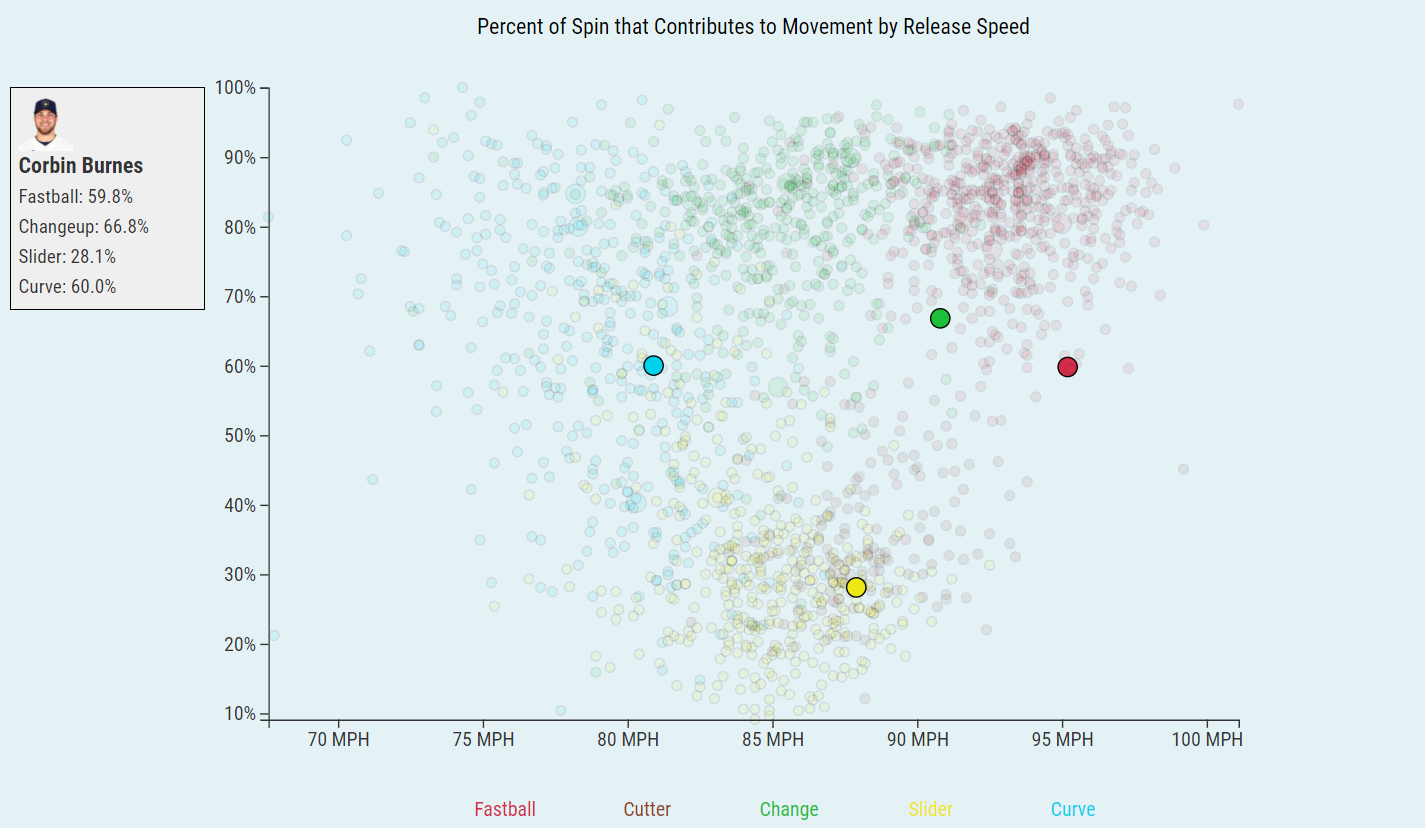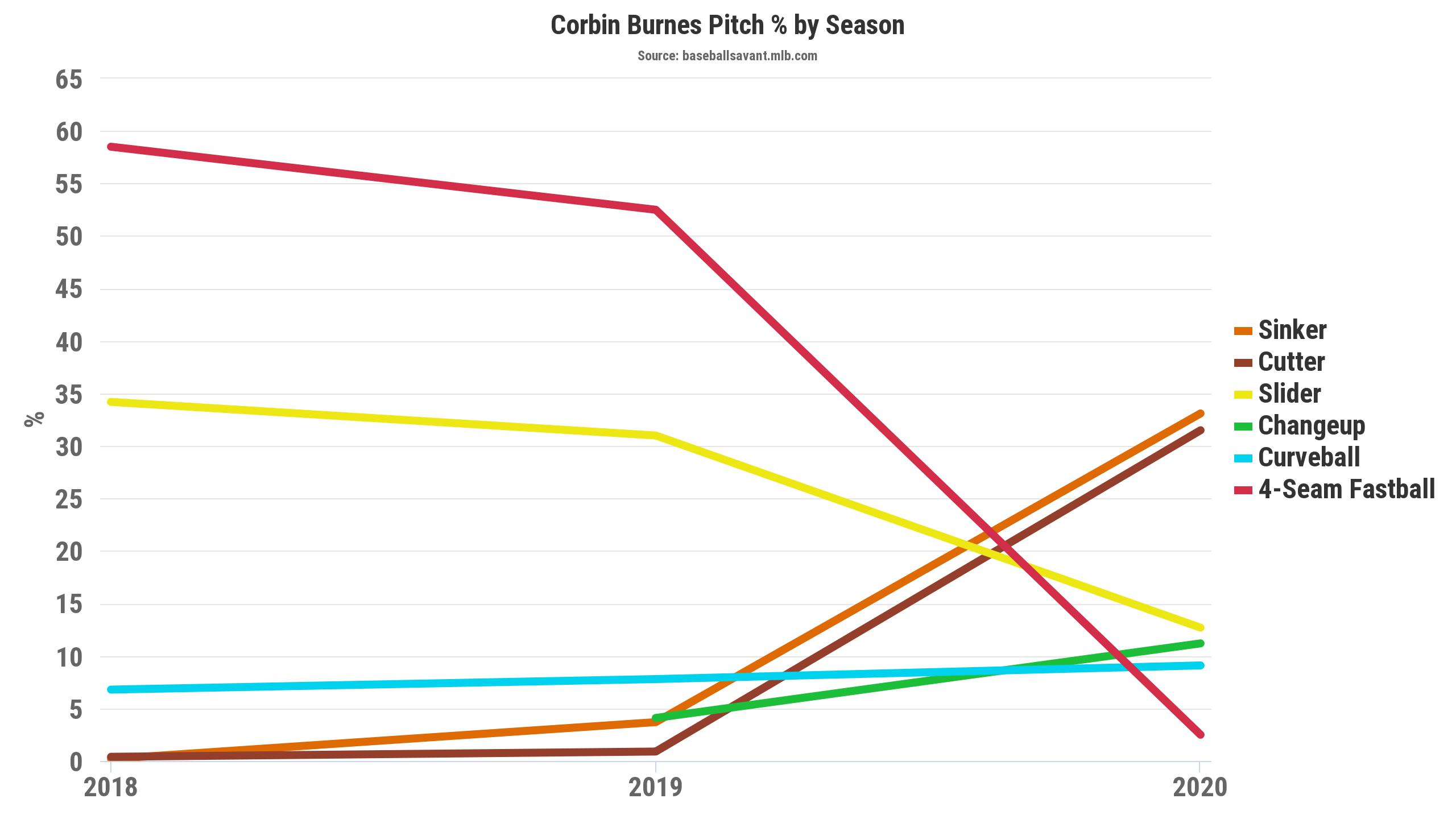Corbin Burnes had one of the most dramatic turnarounds in baseball from 2019 to 2020. As a former top prospect who possessed an enviable combination of high velocity and an elite spin rate, Burnes was a popular pick to break out in his first full MLB season. Instead, he became virtually unplayable. He lost his rotation spot after just four starts. Things failed to get better when he moved to the bullpen, and he was lit up to the tune of an 8.82 ERA in 49 innings.
Burnes struggled so mightily not because his stuff was lacking. Rather, the problem was his arsenal and the way he was using it. In 2019, he was essentially a two-pitch pitcher that relied on a fastball-slider combination. His four-seamer averaged 95.2 miles per hour and had a 99th-percentile spin, yet it was one of the least effective fastballs in the game. Opponents hit .425, slugged .823, and went deep 13 times against it. The velocity and spin were fooling no one; the pitch had a whiff rate of just 20%. Meanwhile, Burnes’ slider was on the other end of the spectrum. It was virtually untouchable: a .181 average, .221 wOBA, and 58% whiff rate.
Burnes’ fastball was doomed for two reasons: location and a lack of active spin. There are more strikeouts in modern baseball than ever before, and much of that is due to the rise of hard fastballs thrown up in the strike zone, a pitch that looks enticing to the hitter until they realize just how difficult it is to get their bat around in time to make contact. Then there was Burnes, who was throwing the majority of his fastballs at the belt or below.

The simple solution would be for Burnes to focus on elevating the fastball more often. Such an adjustment likely would have helped significantly, but his inability to generate movement would still be a problem. Justin Verlander led all qualified pitchers in four-seam active spin in 2019; 98.5% of his spin contributed to the movement on his heater. Burnes had an active spin just of 59.8%, which placed him in the bottom 20 of qualified pitchers and made him a rarity among those who threw in the mid-to-upper 90s. As a result, his fastball had 13% less vertical movement and 73% less horizontal movement than the average four-seam with similar velocity and extension.

Back to the Drawing Board
Burnes went to work over the offseason, and he came back with a fully revamped arsenal. He stopped throwing the previous variation of his fastball almost completely, replacing it with a power sinker. Instead of following his initial offseason plan of building around his slider, he cut his slider usage in half while introducing a new and improved cut fastball. It was a dramatic change, to say the least. Two pitches that were almost nonexistent in his first two seasons became his two primary offerings.

The changes worked. Burnes was the fifth most valuable pitcher in the National League according to the FanGraphs formula for pitcher WAR. He finished the season with a 2.11 ERA and 2.03 FIP. The former Top 100 prospect has finally recognized his potential, right? Not so fast. As encouraging as his 2020 campaign was, there are still adjustments for the 26-year-old to make if he wants to continue finding success.
A Suspect Sinker
As successful as his new approach was, there is one pitch in Burnes’ arsenal to be skeptical about. It happened to be the pitch he used the most in 2020. Per Statcast, the run value for his sinker was -2, meaning that the bottom line results against it were slightly better than average. However, there are reasons to question just how useful it will be moving forward. While it is undoubtedly better than the straighter four-seam than Burnes featured in 2019, it ranked near the bottom of sinkers across the league in average exit velocity (91.6 MPH), barrel rate (11.1%), and hard-hit rate (51.9%) against. In fact, it was similar to his four-seam in these categories. The league-wide ground ball rate against sinkers is typically around 55%, but just 33.3% of batted balls against Burnes’ sinkers were hit on the ground.
The red flags don’t end there. The pitch had the second-highest spin rate among all sinkers in baseball, but in this instance, a high spin rate is a detriment. The best sinkers have a lower spin rate because it increases the effect of gravity on the ball, giving it a heavier sinking action. Due in part to his high spin rate, Burnes had well below average movement for a power sinker (12% less vertically and 17% less horizontally). Burnes was just one of two sinkerballers in this “top” ten; half of the others simply had a few four-seam fastballs miscategorized as sinkers, and the remaining pitchers did not use them especially often.
| Pitcher | Sinker Spin Rate (RPM) | Sinker Usage |
|---|---|---|
| Trevor Bauer | 2796 | 7.0% |
| Caleb Baragar | 2774 | 0.6% |
| Corbin Burnes | 2683 | 33.1% |
| Richard Rodriguez | 2657 | 0.1% |
| Tejay Antone | 2625 | 40.6% |
| Shaun Anderson | 2607 | 1.1% |
| Tanner Scott | 2586 | 1.7% |
| Garrett Richards | 2573 | 8.4% |
| Daniel Bard | 2567 | 14.9% |
| Jeff Samardzija | 2565 | 15.8% |
An opponent batting average of .250 and a .328 wOBA made Burnes’ sinker a serviceable pitch in 2020, but a .314 xBA and .405 xwOBA indicate that he should be thanking the baseball gods for some good fortune.
The other significant change to Burnes’ arsenal, his cutter, is what truly fueled his breakout season. Unlike his sinker, the cutter was undeniably dominant. It excelled in numerous categories across the board. It had a run value of -11, held opponents to a .230 wOBA and .258 xwOBA, and registered a 33.1% whiff rate. When opponents did make contact, they were held to an 84.6 MPH average exit velocity, 23.7% hard-hit rate, and a 57.9% ground ball rate.
Similarly, the right-hander’s other secondary pitches performed extremely well. His slider was just as nasty as ever, inducing whiffs on a whopping 60% of swings and dismantling opponents to a .150 wOBA. Burnes incorporated his changeup into his game plan against left-handed hitters, and he also mixed in the occasional curveball. The slider, changeup, and curve all limited hitters to a sub-.200 wOBA and posted whiff rates of 44% or higher.
Finding the Right Mix
As the season went along, Burnes seemed to realize that his sinker was better served as a supplement to his best weapons than as his primary pitch. After throwing primarily sinkers for much of the season, his usage of the pitch steadily dropped over his final four starts. His cutter took over as his go-to offering.

Note: Burnes did not join the rotation for good until August 18.
It should be noted that like many pitchers, Burnes used different plans of attack based on the handedness of each hitter he faced. For the season, righties saw primarily sinkers (44.3%), and Burnes would use his wipeout slider to put them away. Lefties saw the cutter more than any other pitch (41.4%) and more changeups than righties did. However, his surging cutter usage was not simply the result of facing lineups loaded with left-handed hitters. The presence of the sinker decreased against righties as well and gave way to more cutters and sliders. Burnes posted a strikeout rate of 40.7% and a 1.36 FIP in his final four outings compared to a 34.4% strikeout rate and 2.41 FIP in his first eight appearances.

None of this is to suggest that Burnes should shelve his sinker. It directly contributes to the effectiveness of the cutter and slider because it tunnels so well with those pitches. Burnes also needs to feature every piece of his repertoire to keep hitters off-balance as he faces them multiple times in an outing. While the sinker may not an exceptional pitch on its own, it still plays an important role in his arsenal as a whole. Burnes has one of the best sliders in the game, and his cutter is on pace to follow suit. Altering his game plan to give some of the sinker’s attention to his other pitches may be a wise path to take moving forward.
Burnes shouldn’t be expected to replicate his 2.11 ERA next season. His unsustainably low 4.7% HR/FB ratio will experience inevitable regression, and he still struggles periodically with his control. However, there is no denying that the exciting right-hander has some true weapons in his arsenal. The last few starts of his 2020 campaign indicate that he is still making adjustments as he figures out how to best utilize his strengths and find sustained success. Expect those adjustments to continue in 2021.



